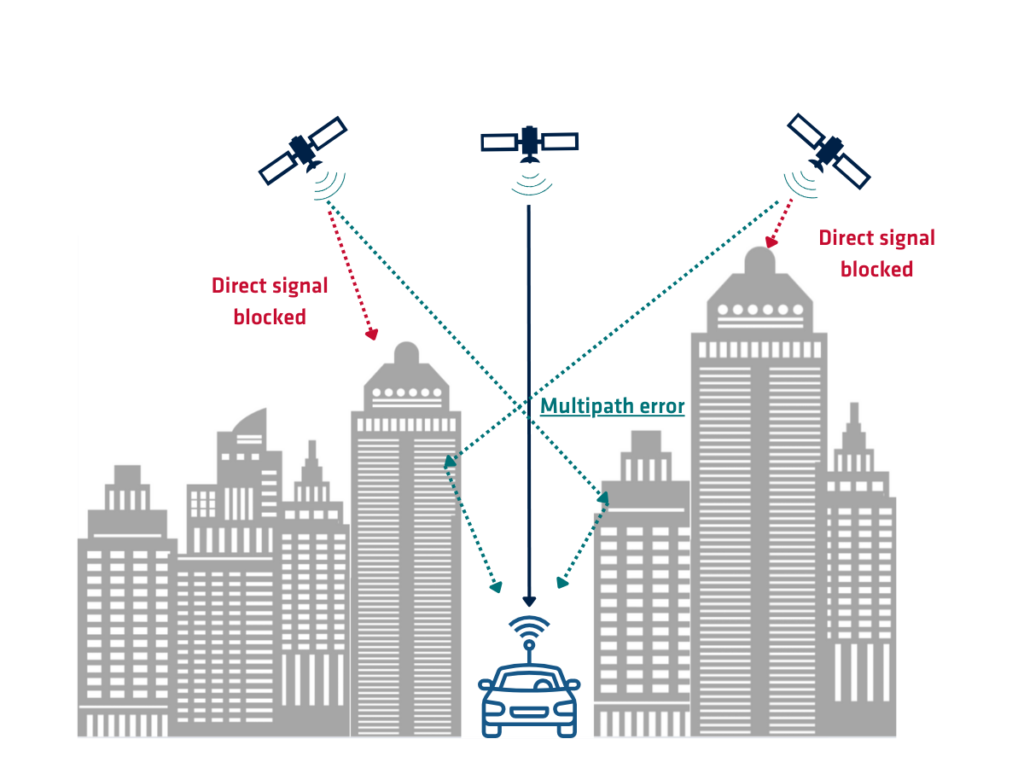Multipath error is a common issue in satellite-based positioning systems, such as Global Navigation Satellite Systems (GNSS). It occurs when signals from a satellite reach the receiver through multiple paths, causing inaccuracies in the positioning data. Understanding and mitigating multipath error is crucial for improving the precision of GNSS systems used in navigation, surveying, and various scientific applications.
It can also be defined as inaccuracies in GNSS positioning that result from the reflection or scattering of satellite signals off surfaces such as buildings, trees, or the ground. Instead of receiving a direct signal from the satellite, the receiver detects multiple signals that have traveled different paths to reach the antenna. The interference caused by these reflected or scattered signals results in errors in the calculated position.

The main aspects of multipath error are:
- Signal Reflection: Reflected signals bounce off surfaces before reaching the receiver, causing discrepancies in signal timing and positioning calculations.
- Signal Scattering: Scattered signals spread out after hitting irregular surfaces, further complicating the reception and measurement of accurate data.
- Path Difference: The varying lengths of the signal paths result in differences in signal travel time, contributing to positioning errors.
3 causes of multipath error
Multipath error is influenced by various environmental and technical factors. Understanding these causes helps in developing effective strategies for minimizing their impact on GNSS accuracy.
1 – Reflective surfaces
Hard surfaces such as buildings, pavement, and water bodies can cause satellite signals to reflect. These reflections reach the receiver along with the direct signal, causing errors in the measurement of signal travel time.
Urban environments
In cities with dense buildings and infrastructure, multipath error is more pronounced due to the increased number of reflective surfaces. This can severely affect the accuracy of positioning systems in urban settings.
Water bodies
Large bodies of water, such as lakes and oceans, can reflect GNSS signals, leading to multipath error. The reflective nature of water surfaces can cause complex signal interference.
2 – Surface irregularities
Surface Irregularities: Irregular or uneven surfaces can scatter GNSS signals in multiple directions. These scattered signals can mix with the direct signals, creating errors in the position calculation.
Terrain features
Natural features like hills, trees, and rocky outcrops can scatter and reflect GNSS signals, contributing to multipath error. The irregularities in terrain affect signal propagation and reception.
Man-Made structures
Structures such as antennas, fences, and vehicle surfaces can also cause signal scattering and reflection. These structures introduce additional paths for the signal to travel, increasing the potential for multipath error.
3 – Atmospheric Conditions
Variations in atmospheric conditions, such as temperature and humidity, can affect the propagation of GNSS signals. These conditions can indirectly influence multipath error by altering the characteristics of reflected or scattered signals.
Temperature Variations
Temperature changes can affect the density and composition of the atmosphere, influencing the propagation and reflection of GNSS signals.
Humidity Levels
High humidity can cause changes in the refractive index of the atmosphere, impacting the signal path and contributing to multipath error.
Mitigation Strategies for Multipath Error
Several techniques and technologies are employed to reduce the impact of multipath error on GNSS positioning accuracy. Implementing these strategies can significantly enhance the reliability of navigation systems.
Advanced receiver technology
Modern GNSS receivers are equipped with advanced signal processing capabilities to identify and mitigate multipath interference. These receivers use algorithms to distinguish between direct and reflected signals.
Multipath detection algorithms
Receivers use algorithms to detect and filter out multipath signals. These algorithms analyze the characteristics of incoming signals to separate direct signals from reflected ones.
Signal processing techniques
Advanced signal processing techniques, such as adaptive filtering and correlation analysis, help reduce the effects of multipath error. These techniques improve the accuracy of positioning by enhancing the quality of received signals.
Antenna design
The design and placement of GNSS antennas play a crucial role in minimizing multipath error. Antennas with specific designs can reduce the sensitivity to reflected signals.
Ground planes
Using ground planes or reflective surfaces around the antenna can help improve signal reception by reducing the impact of reflections from nearby surfaces.
Antenna placement
Proper placement of GNSS antennas, away from reflective surfaces and potential sources of interference, helps reduce multipath error. Ensuring a clear line of sight to the sky minimizes the chances of signal reflections and scattering.
Survey and data processing techniques
In surveying and scientific applications, post-processing techniques can be used to correct for multipath errors. These techniques involve analyzing data collected over time to identify and correct errors caused by multipath effects.
Post-processing corrections
Post-processing software tools and algorithms can analyze recorded GNSS data to identify and correct multipath errors. These corrections improve the accuracy of positioning and measurement results.
Use of reference stations
Reference stations with fixed locations can provide correction data to adjust for multipath errors in GNSS measurements. This technique is commonly used in high-precision applications.
Multipath error is a significant challenge in GNSS positioning that arises from the reflection and scattering of satellite signals. By understanding the causes of multipath error and implementing effective mitigation strategies, it is possible to enhance the accuracy and reliability of GNSS systems.
Advanced receiver technology, proper antenna design, and data processing techniques play key roles in addressing multipath interference, ensuring that navigation and positioning applications achieve optimal performance in various environments.
